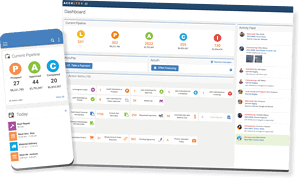The roofing industry is experiencing rapid growth, fueled by increasing demand for home improvements and repairs. But, the reality is that more than 56% of roofing companies fail within their first 3 years of operation.
Many contractors enter the business with strong technical skills and a passion for the trade, but starting a successful roofing company requires more than just delivering quality work. Common reasons why roofing companies fail—ranging from poor customer service to inefficient operations—often lead to business failure.
As the #1 roofing software, AccuLynx understands how important it is for new companies to set themselves up for growth. To help you do that, we’ve identified the 7 reasons why roofing companies fail—and how you can avoid these traps by using our business management software.
Why roofing companies fail
Fail #1: No established processes
The problem
One of the biggest mistakes roofing contractors make is being disorganized. This doesn’t mean your physical desk is messy. Rather, there are no processes to guide you and your team members as you work to grow your business and take on more jobs.
Roofing contractors that do not have an organized set of processes in place often struggle managing new leads, communicating with customers, and tracking projects throughout the pipeline. When employees don’t know what steps to take or who is responsible, mistakes are common and delays are inevitable.
The solution
Make sure you have a well-defined process documented for everyone to follow. For example, using the Workflow Manager in AccuLynx, you could set up customized checklists for different types of jobs that include your standard procedures and timeline, as well as all safety and OSHA roofing standards that have to be met. You can also automatically assign tasks directly to team members in AccuLynx, so there’s no confusion about who is responsible for what.

Fail #2: Inefficient and inaccurate reporting
The problem
Some roofing business owners get so overwhelmed with everyday tasks that they can’t keep up with trends in how their business is performing. Others lack access to business data that would give them crucial insights. Business owners that can’t identify areas of weakness and don’t discover issues until it’s too late will likely fail.
The solution
Business owners should regularly review KPIs related to your:
- Overall profits and losses
- Accounts receivable
- Accounts payable
- Average job costs and profits
- Sales closing rates
- Marketing spend
AccuLynx gives you access to a huge library of pre-built and customizable reports allowing you to keep track of your data and results easily and efficiently. You can have reports delivered to your inbox automatically on a weekly and monthly basis so you can spot potential problems before they have a chance to harm your business.
Fail #3: Wasted time
The problem
There are only so many hours in a day. When team members spend time on repetitive tasks, like data entry, emailing homeowners, and chasing down signatures, they’ll have little time left for more productive, business growth-related job functions. In some cases, roofing companies have to hire extra staff members to cover these gaps, increasing costs and cutting into profits.
The solution
Repetitive tasks can be automated—or even eliminated—with the help of a roofing business management software. For example, you can use the AccuLynx Automation Manager to set up automated text or email appointment reminders, rather than having a staff member manually send a message whenever an appointment is coming up.
AccuLynx integrates with other tools your business uses, like accounting software and lead gen tools. This eliminates the need for manual data entry in multiple places, saving you time and reducing errors. In fact, by streamlining these tasks, AccuLynx customers save an average of 9 hours per user each week—time that can be better spent growing your business and serving your customers.

Fail #4: Lack of investing in the business
The problem
Paying for the best tech, employee training, new tools, and other expenses can seem like too high a cost. Some roofing businesses decide not to spend the money, but roofers that don’t invest in their operations struggle to find and keep employees..
The solution
As the old saying goes, you have to spend money to make money. Successful roofing companies are those that take the time to invest in themselves, their employees, their equipment, and their technology. What may seem like an additional upfront cost can prove to be a very profitable return on investment.
Calculate your potential ROI with AccuLynx →
One particularly impactful purchase for most businesses is a roofing software system. Research shows that small businesses that invest in CRM software like AccuLynx, on average, see sales increase by 29% and sales productivity increase by 34%. Roofing CRMs give employees a faster and more organized way to do their daily work, ensuring a foundation for growth while also attracting more tech-savvy talent.
Fail #5: Not embracing change
The problem
It can be easy to subscribe to an, “if it ain’t broke, don’t fix it,” attitude. However, what worked for you as a small company might not be what your company needs now. Keeping things the same can stunt your company’s growth and cause frustrated employees to leave.
In addition, the roofing market is changing daily, with new competitors and new technology entering the field. By sticking to familiar routines and tools, your roofing companies may fail and lose business to others who are on the cutting edge.
The solution
Stay up to date on residential roofing trends and new technology in order to have a better understanding of what your business needs to succeed. Stay informed and learn how your business can benefit by:
- Subscribing to industry publications or joining local roofing associations
- Taking note of what your competitors are doing
- Attending trade shows
Embracing change is easier when the technology you use to manage your business is also staying up to date. At AccuLynx, we’re always adding new features to our software based on the changing needs of roofers, so you can be confident our tools will help you keep up.

Fail #6: Too much employee turnover
The problem
Many contractors are so eager to start work right away that they will hire anyone. However, just because an employee might be qualified does not mean they are right for your company. Not considering whether someone is a good fit for your company culture will make it hard to build a strong team and lead to employees leaving.
Some contractors spend lots of effort building the perfect team, but don’t invest in teaching new employees or offer continued training. When employees don’t feel supported, they lose motivation to work hard and are less likely to stick around, leading to your roofing company failing.
The solution
Take the time you need to find someone who has the right skills and character. You should be comfortable at all times with them being the face of the business. This means your team should respect homeowners and their property, maintain a high standard of work quality, and stay diligent in keeping projects on schedule.
New employees (and old ones) should be trained in the expectations that you have for their role, as well as the processes you’ve established to uphold your company’s quality standards. Training could involve anything from giving them a demo of your product or services to sending them to a coach or mentor within your organization who can help them define their role and succeed.
Fail #7: Poor marketing
The problem
It can be difficult to know where to start when it comes to marketing. Many contractors are not sure where to invest or what the best roofing marketing strategies are, and as a result, find themselves investing their time and efforts poorly with little to no returns.
The solution
The first step to ensuring you have effective marketing is to identify the type of homeowners you are looking to target. One way to do this is to review your most profitable jobs in the past year and look at the demographics of those customers. (The Job Profitability Report in AccuLynx can help you quickly identify this information.)
Once you know where your most profitable jobs come from, you can maximize your reach by spending time and money pursuing those leads. This can include a variety of marketing tactics, such as:
- Paid advertising on social media
- Asking past customers for referrals
- Adding a form to your website to capture lead information
- Adding your name to a directory of local businesses
Regardless of the marketing strategy you choose, it’s important to review it periodically to make sure it’s working and adjust your plan accordingly.

The best roofing software to help your business succeed
To keep your roofing company from failing, you’ll need the right tools and strategies. AccuLynx roofing software is designed to streamline your everyday tasks so your business can stay on the path to long-term growth. To learn more about the features in AccuLynx that can help you succeed, schedule a custom demo today.

